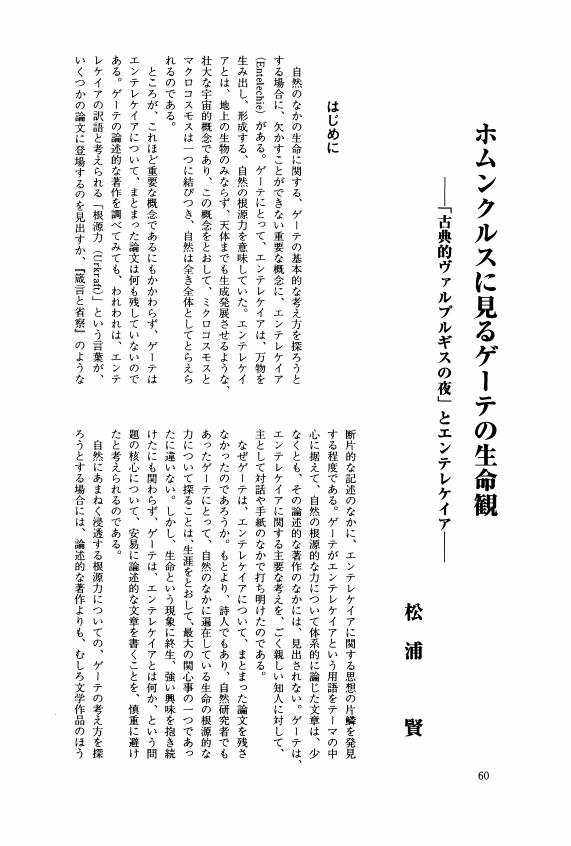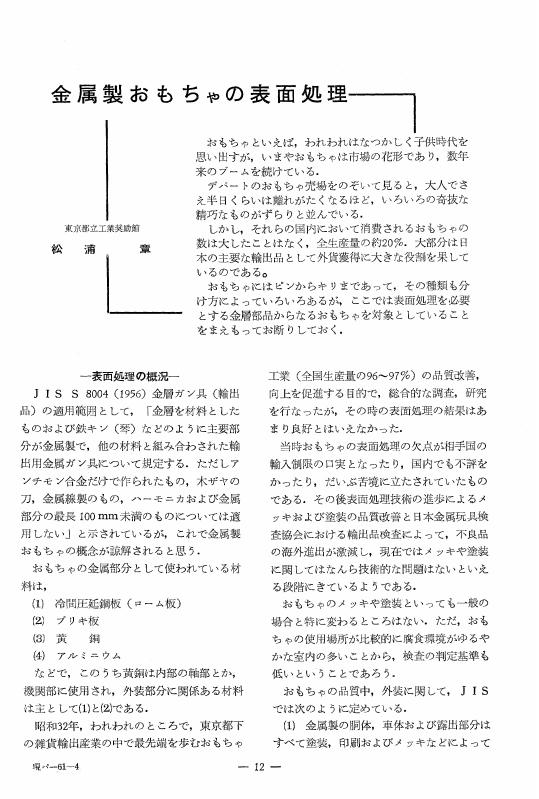1 0 0 0 OA ホムンクルスに見るゲーテの生命観 ―「古典的ヴァルプルギスの夜」とエンテレケイア―
- 著者
- 松浦 賢
- 出版者
- ゲーテ自然科学の集い
- 雑誌
- モルフォロギア: ゲーテと自然科学 (ISSN:0286133X)
- 巻号頁・発行日
- vol.1998, no.20, pp.60-77, 1998-10-24 (Released:2010-02-26)
- 参考文献数
- 23
1 0 0 0 OA ポーランド経済と「中所得国の罠」
- 著者
- 松浦 光吉
- 出版者
- ロシア・東欧学会
- 雑誌
- ロシア・東欧研究 (ISSN:13486497)
- 巻号頁・発行日
- vol.2016, no.45, pp.170-183, 2016 (Released:2018-06-02)
- 参考文献数
- 25
Since 1992 Poland has enjoyed positive GDP growth for 25 years, including 2009 which was a harsh year due to the global recession. It is also forecasted that its good development will further continue for several coming years. Some economic analysts attribute the important role of EU funds (grants from the EU) and foreign direct investments (FDI) for the successful GDP growth. The GDP ratio of foreign capital is 3.2% and 4.8% for EU funds and for FDI respectively, which is a relatively high ratio totaling 8% of the Polish economy. 20% of EU funds are allocated to Poland, and this makes it the top beneficiary. The inflow of FDI is also the top among Central and Eastern European Countries (11 countries).Despite its long period of successful economic growth, it seems that an economic level (represented by GDP per capita) has not converged with the EU average and has been stagnant in recent years. Under these circumstances, it is not surprising that arguments for the Middle-Income Trap in the Polish economy are gradually increasing. That is whether Poland faces the Middle-Income Trap or is already in it.What is the background of the Middle-Income Trap? Here we look at not only the positive side of foreign capital but the negative side as well. The positive side is its function as a powerful engine to drive the Polish economy. The negative side is an unwanted effect causing an excessive dependence on foreign capital, which constrains or at the very least, deteriorates self-sustainable growth, resulting in stagnation of future growth. In order to keep competitiveness needed for continuing growth and to avoid the Middle-Income Trap, it is essential to reform the industrial structure from labor-intensive to capital/knowledge-intensive industry through successive innovation.On February 16, 2016 Polish authorities released the Action plan for responsible development of Poland. It is a remarkable plan, because it officially acknowledged five development traps (The Middle-Income Trap, Lack of balance trap, Average product trap, Demographic trap, and Weak institutions trap), which Poland currently faces. Before the publication of this plan, Polish authorities often appealed for EU funds or FDI, and claimed the acquisition as their diplomatic or political achievement without any mention of possible traps.On June 23, 2016, it was decided that the UK would withdraw from the EU through a referendum, known as Brexit. As the UK’s economic size is the second largest in the EU, there is concern about continued political and economic turbulence for at least a couple of years. And the withdrawal of the UK from the EU will cause a reduction in the EU budget including EU funds, which will be an external shock on Polish economic growth.This paper focuses on the background and development of economic growth and the Middle-Income Trap in Poland.
1 0 0 0 OA ポーランド経済とEUファンド
- 著者
- 松浦 光吉
- 出版者
- ロシア・東欧学会
- 雑誌
- ロシア・東欧研究 (ISSN:13486497)
- 巻号頁・発行日
- vol.2015, no.44, pp.87-98, 2015 (Released:2017-08-18)
- 参考文献数
- 23
- 被引用文献数
- 2 4
Poland has shown strong economic growth for 20 years since 1995, and is also the only EU country that achieved positive GDP growth in 2009 during the global recession. Several studies have looked at the causes of this good economic performance, and attribute it to such as the effective utilization of EU Funds, stimulus by macroeconomic policy, devaluation of Polish currency, prudential control or regulation in the financial system and so forth. Poland is a country well favored with foreign aid both before and after its accession to the EU from international institutions including the EU. When the focus is given to EU Funds after joining the EU on May 1, 2004, it is easy to understand that such funds play an important role as key driver of economic growth in Poland. Poland enjoys a comparatively big allocation of EU Funds, indeed it was the top recipient of funds when the Multiannual Financial Framework (MFF) was in effect (2007–2013). The financial transfer of EU Funds is 3.7 times greater than the Polish contribution to the EU, and this amounts to 4% of Polish overall GDP (3% by Structural Fund and 1% by Common Agricultural Policy (so called CAP)) according to 2013 statistics. Furthermore the ratio of EU Funds to the governmental budget is 10-20%. The G20 members at the London Summit 2009 agreed to a financial stimulus of around 3% of GDP to mitigate the global recession. Thus the 4% of GDP from EU Funds should contribute greatly to Polish GDP growth. EU funds can be classified by 2 main categories, one is Structural Funds and the other is CAP payments mentioned above. Structural Funds are used to support the modernization of infrastructures by member states or between member states. Therefore it can be utilized as fiscal investment to promote GDP growth. Most CAP payments are allocated to farmers as direct-aid payments, which may result in an expansion of domestic demand (as household consumption). In fact, GDP ratio of the construction industry in Poland is 2% higher than in other EU member states, and the consumption propensity is also 5% higher. EU Funds are costless financial grants from the EU without any fiscal burden falling on the Polish government. Hence there is no serious concern about crowding-out in the financial market, nor about rising interest rates of government bonds. EU Funds are, therefore, a very effective tool for Polish authorities to control economic growth. As they fully understand its function and importance in their national economy, Poland had tried as much allocation of EU Funds as possible under the current MFF regime. In the recent economic forecast by the EU, Poland is expected to continue its good economic performance in the coming years mainly due to robust domestic demand. But there is fear that the Polish economy may fall into the Middle-income trap over the long-term, if they continue to depend on EU Funds for the progress of their economy.
1 0 0 0 オンライン・バカ : 常時接続の世界がわたしたちにしていること
- 著者
- 松浦 茂
- 出版者
- 内陸アジア史学会
- 雑誌
- 内陸アジア史研究 (ISSN:09118993)
- 巻号頁・発行日
- vol.24, pp.143-150, 2009-03-31 (Released:2017-10-10)
1 0 0 0 OA ドイツにおけるサイバー安全保障と防衛憲法 ―政府による取組と議会における論義を中心に―
- 著者
- 松浦 一夫
- 出版者
- 憲法学会
- 雑誌
- 憲法研究 (ISSN:03891089)
- 巻号頁・発行日
- vol.54, pp.1, 2022 (Released:2022-07-04)
- 著者
- 松浦 明宏
- 出版者
- 東北哲学会
- 雑誌
- 東北哲学会年報 (ISSN:09139354)
- 巻号頁・発行日
- vol.31, pp.35-50, 2015 (Released:2022-08-04)
1 0 0 0 OA 追悼 柴田三千雄さんの思い出 柴田先生のお仕事
- 著者
- 松浦 義弘
- 出版者
- 日仏歴史学会
- 雑誌
- 日仏歴史学会会報 (ISSN:24344184)
- 巻号頁・発行日
- vol.27, pp.71-72, 2012 (Released:2020-04-03)
1 0 0 0 大学生用コロナ禍ソーシャルサポート尺度の作成(2)
- 著者
- .*上田 仁 .松浦 均
- 雑誌
- 日本心理学会第86回大会
- 巻号頁・発行日
- 2022-07-29
1 0 0 0 OA 卵巣移動術後17年を経て発症し腹腔鏡下に摘出した卵巣嚢腫の1例
- 著者
- 橋之口 朝仁 定永 倫明 本坊 拓也 吉田 倫太郎 坂井 邦裕 松浦 弘
- 出版者
- 日本臨床外科学会
- 雑誌
- 日本臨床外科学会雑誌 (ISSN:13452843)
- 巻号頁・発行日
- vol.80, no.8, pp.1538-1541, 2019 (Released:2020-03-18)
- 参考文献数
- 7
症例は54歳,女性. 21年前に子宮頸癌 (Stage I B)に対して腹式単純子宮全摘術,術後放射線療法を受けた.増大傾向にある左側腹部に存在する腫瘍の精査加療目的で当院外科へ紹介となった.MRIでは左腎外側に径11cm大の嚢胞性腫瘤を認めた.外来受診時,「子宮頸癌手術時に卵巣を温存し吊り上げている」とのことであり,婦人科へコンサルトした.子宮頸癌の術後放射線療法に際して,卵巣機能温存目的に被曝を避けるため卵巣を照射野外に移動固定する術式が選択された可能性が考えられた.卵巣移動術後の左卵巣嚢腫を疑い,腹腔鏡下腫瘍摘出術を施行した.病理組織学的検査で卵巣粘液性嚢胞腺腫 (良性)と診断した.術後は順調に経過し,術後7日目に自宅退院となった.
1 0 0 0 OA 古代の宮都の移転と河川 ―長岡京,平安京への遷都を中心に―
- 著者
- 松浦 茂樹
- 出版者
- 一般社団法人 日本治山治水協会
- 雑誌
- 水利科学 (ISSN:00394858)
- 巻号頁・発行日
- vol.37, no.2, pp.41-63, 1993-06-01 (Released:2019-05-02)
- 参考文献数
- 13
1 0 0 0 OA 港湾・海岸構造物の合理的設計を目的とした確率台風モデルの構築と精度の検討
- 著者
- 橋本 典明 川口 浩二 河合 弘泰 松浦 邦明 市川 雅史
- 出版者
- 公益社団法人 土木学会
- 雑誌
- 海岸工学論文集 (ISSN:09167897)
- 巻号頁・発行日
- vol.50, pp.176-180, 2003-10-10 (Released:2010-03-17)
- 参考文献数
- 5
- 被引用文献数
- 1
1951~2000年の50年間に日本付近に来襲した台風データに基づいて確率台風モデルを改良した. 本研究では, 台風位置 (緯度, 経度) の時間変化量の偏差を2次元ARモデルにより季節別にモデル化した. 一方, 台風中心気圧・最大風速半径に関しては, 1次元ARモデルにより季節別にモデル化した. このモデルを用いて, モンテカルロシミュレーションを行った結果, 台風経路の再現性が改善され, 台風中心気圧の平面分布は概ね実データのそれと一致した. また, 過去50年間に伊勢湾に接近した台風の最大気圧降下量も, 実データは概ねシミュレーションの標偏差内に入っていることから, 本研究で改良・構築した確率台風モデルは妥当なモデルであると考えられる.
1 0 0 0 OA 前立腺部尿管異所開口を有する前立腺癌に対し前立腺全摘除術を施行した1例
- 著者
- 舟橋 康人 上平 修 春日井 震 木村 恭祐 深津 顕俊 松浦 治
- 出版者
- 一般社団法人 日本泌尿器科学会
- 雑誌
- 日本泌尿器科学会雑誌 (ISSN:00215287)
- 巻号頁・発行日
- vol.98, no.3, pp.580-582, 2007-03-20 (Released:2010-07-23)
- 参考文献数
- 5
症例は71歳男性, 頻尿を主訴に当科受診した. PSA8.0ng/mlにて前立腺針生検を施行, 中分化腺癌と診断された. 画像診断にて前立腺部尿道に異所開口する右側完全重複尿管と診断された. 前立腺全摘除術時に尿管尿管吻合を施行した. 術後11ヵ月現在, 水腎症および腫瘍の再発を認めていない. 尿管異所開口を有する前立腺癌に対する前立腺全摘除術に関する報告は稀であり, 若干の文献的考察を加えて報告する.
1 0 0 0 OA 大腸手術における手術部位感染(SSI)を予防する合理的な血糖コントロール
- 著者
- 橋爪 正 神田 大周 久保田 隼介 一戸 大地 横山 拓史 山田 恭吾 松浦 修
- 出版者
- 一般社団法人 日本外科感染症学会
- 雑誌
- 日本外科感染症学会雑誌 (ISSN:13495755)
- 巻号頁・発行日
- vol.16, no.1, pp.18-25, 2019-03-30 (Released:2019-07-13)
- 参考文献数
- 23
術後高血糖は大腸手術の手術部位感染(SSI)リスク因子である。1990~2009年の初回開腹腸切除 2,099例を対象として,全例に SSI予防バンドルを施行し,1990~1999年(前期)は血糖目標値200mg/dL,随時インスリン皮下注(SCI)法を行った。前期の糖尿病患者の創部 SSI率は17%と高かった。2000~2009年(後期)は目標血糖値を150mg/dLに変更し,一部の糖尿病と耐糖能異常に5%または7.5%糖濃度の維持輸液を投与し,術後 48時間まで持続インスリン静注(CII)法を行うきめ細かな血糖管理を前向きに実施した。CII法は SCI法に比べてすみやかに高血糖を改善し,血糖変動が少なく,術後 2~4時間で血糖値は安定した。著しい低血糖の発生もなかった。後期糖尿病患者の創部 SSI率は10%まで改善した(非糖尿病9.3%)。150mg/dLを目標とするきめ細かな血糖管理は大腸手術 SSI予防に有用と確認された。最近の SSIガイドラインは血糖目標値 150~200mg/dLを示しているが,今後も周術期血糖管理に関して詳細な検討が必要と思われる。
1 0 0 0 ナチュラル・ウーマン
1 0 0 0 OA 金属製おもちゃの表面処理
- 著者
- 松浦 章
- 出版者
- 一般社団法人 表面技術協会
- 雑誌
- 金属表面技術 現場パンフレット (ISSN:03685527)
- 巻号頁・発行日
- vol.8, no.4, pp.12-15, 1961-04-15 (Released:2009-10-07)
1 0 0 0 OA 本邦休廃止鉱山における地下水流動解析を適用した発生源対策の検討 –旧松尾鉱山を例として–
- 著者
- 亀山 正義 田原 康博 吉田 堯史 松浦 太一 宮吉 紗綾子
- 出版者
- 一般社団法人 資源・素材学会
- 雑誌
- Journal of MMIJ (ISSN:18816118)
- 巻号頁・発行日
- vol.138, no.7, pp.103-115, 2022-07-28 (Released:2022-07-28)
- 参考文献数
- 19
In some cases, mine drainage containing heavy metals (arsenic, cadmium, lead, and other metals) continues to flow out from mine mouths and accumulation sites in abandoned metal mines. The local governments that manage the abandoned mines continue to treat mine drainage water day and night. Therefore, practical and realistic measures to reduce the volume of mine drainage are required. A large amount of data on mine drainage has been accumulated for a long time at each mine. Also, several technologies have been introduced that make it possible to understand the actual hydrological water flow of mine drainage and to predict the quantitative effects of countermeasures. Under these circumstances, JOGMEC applied a surface water-groundwater coupled simulation technique to the old Matsuo Mine located in Hachimantai City, Iwate Prefecture. The simulation was used as a part of the results of the "Research and Study on Groundwater Control Technology" of the " Advanced Research and Study for Mine Drainage Treatment in Abandoned Mines Project", a project commissioned by the Ministry of Economy, Trade and Industry of Japan. It was confirmed that the existing countermeasures were efficient and effective under the limited budget. Thus, proving that it was the best practice.
1 0 0 0 OA 戦国軍記『武功夜話』における偽書説について : 語彙による年代確定の危うさ
- 著者
- 松浦 由起
- 出版者
- 独立行政法人 国立高等専門学校機構豊田工業高等専門学校
- 雑誌
- 豊田工業高等専門学校研究紀要 (ISSN:02862603)
- 巻号頁・発行日
- vol.37, pp.A19-A32, 2004-11-25 (Released:2017-04-27)
1 0 0 0 外来アリの侵略機構の一般的解明:日本からの侵入者に焦点を当て
生物学的侵略機構の研究には自然分布域と侵入域の比較が不可欠である。日本ではあまり知られていないが、近年北米で日本由来の複数の外来アリ種による環境被害が広がっている。しかし皮肉にもこれは日本の研究者にとって居ながらにして侵略アリの自然個体群情報を収集できる絶好の機会である。そこで、本研究では侵略的外来昆虫研究の日米のエキスパートが協力し、これら日本からの侵入者の生態・行動・遺伝情報を侵入先と自然分布域である日本国内で徹底比較する。さらに広大な国土を持つ米国で日本では不可能な野外実験を行う。既存の諸学説を整理しながら網羅的にテストすることで外来アリの侵略機構に関する一般論を導く。以上の目的で研究を始めたが、初年度冒頭に代表者の不測の病気が発覚し研究が遅延した。そこで、2年度目以降は遅れを取り戻すべく主として以下の研究を鋭意進めている。まず、米国側のカウンターパートと協力し、オオハリアリ、アメイロアリ、トビイロシワアリの各国個体群の基礎データを収集した。とくにトビイロロシワアリの炭化水素データを重点的に収集した。また多数外来アリが分布する沖縄では外来アリと在来アリの比較研究を室内および野外で進め、外来種を含むアリには採餌機能に関する複雑なトレードオフが存在することを立証した。また、日米比較の最大の成果として、オオハリアリが侵入前の原産地である日本国内においても侵略先の米国個体群と同様に、高度な巣内近親交配を行なっていることを明らかにし国際誌に発表した。これは近親交配耐性が侵略の前適応であることを示した世界初の成果である。また、テキサスのフィールドに研究代表者が研究室の学生らとともに訪問し実験のプロットを設置しており、2017年夏に2度襲来したハリケーンのため野外プロットが水没した遅れを取り戻すべく鋭意研究を進めている。H30年度にはプロットを再設置した。









